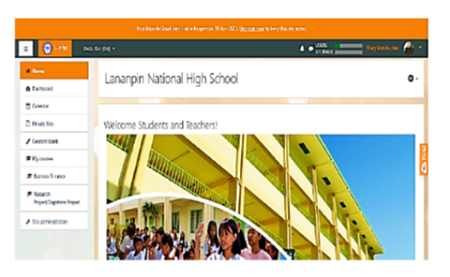


Indian Journal of Science and Technology
DOI: 10.17485/IJST/v14i39.1142
Year: 2021, Volume: 14, Issue: 39, Pages: 2982-2997
Original Article
Mary Ann A Aguilar1, Jeroll C Braganza2, Gemalyn D Guiwanas3, Eugene C Magpayo3, Frederick F Patacsil4*
1Lananpin National High School, Urdaneta City, 2428, Philippines
2San Nicolas National High School, Patricio St., San Nicolas, Pangasinan, 244, Philippines
3Cuyapo National High School, Bulala, Cuyapo, Nueva Ecija, 3117, Philippines
4Pangasinan State University-Urdaneta City Campus, 2428, Urdaneta City, Philippines
*Corresponding Author
Email: [email protected]
Received Date:21 June 2021, Accepted Date:03 November 2021, Published Date:25 November 2021
Background/ Objectives: The use of technology such as Learning Management System (LMS) is helpful during the pandemic to enforce distance learning in public schools in the Philippines. The Department of Education (DepEd) introduced various formats and platforms to teachers to cope with the situation mentioned and to attain continuous learning amidst any circumstances. However, in some cases like in Lananpin National High School (LNHS) which used to implement traditional method, modernization without consideration of technological acceptability issues has reduced the influence of e-learning and the desired academic achievement. In this regard, the researchers conducted this study to find out the level of acceptability and usability of i-lnhs; a learning management system for Lananpin National High School using an e-learning platform, Modular Object-Oriented Dynamic Learning Environment (Moodle), to address the existing learning gaps. The objective of this research is to examine the implementation of i-lnhs to help the teachers and students facilitate learning and easily monitor students’ progress. Methods: This study used a descriptive and developmental research design. A questionnaire survey was used to assess teacher and student acceptance in implementation, content validity, and technological acceptability. Respondents were purposively chosen; 11 senior high school teachers and 40 senior high students. Data was obtained using Google Forms and was analyzed thereafter. Findings: The result showed that the implementation of i-lnhs in terms of functions and capability requirements, user interface and design, content validity, technical quality, and usability were acceptable to teachers and students. Therefore, the use of this technology could address the gaps of distance learning and the skepticism of teachers and students to adapt shift in learning methodology.
Keywords: ilnhs; Learning Management System; Moodle; elearning; Descriptive and Developmental research design
© 2021 Aguilar et al. This is an open-access article distributed under the terms of the Creative Commons Attribution License, which permits unrestricted use, distribution, and reproduction in any medium, provided the original author and source are credited. Published By Indian Society for Education and Environment (iSee)
Subscribe now for latest articles and news.